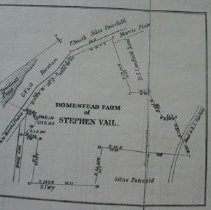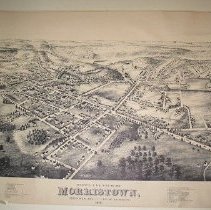Archive Record
Images


Metadata
Title |
Speedwell Site Papers |
Scope & Content |
Speedwell Site Papers, Parent Record The Speedwell Site Collection materials relate to the institutional history of the site as a non-profit and governmental institution. These documents are an excellent source of information for researchers interested in the institutional and site related history of Historic Speedwell, early historic preservation efforts, and local history related articles and research. Additional materials related to local Morristown history add to the interpretation of the site and are used as a resource for research and display. |
Object Name |
Fonds |
Catalog Number |
HS2013.003 |
Collection |
Historic Speedwell Collection |
Physical characteristics |
2 boxes or 1 linear foot of material as well as oversized item in map case and audio stored digitally. |
Creator |
Various Creators |
Biographical History |
Historic Speedwell was incorporated as Speedwell Village in 1966 as a non-profit, educational historic site. The non-profit ran the site from 1966-2001, completing restoration programs, conducting tours and creating exhibits. The Morris County Board of Chosen Freeholders acquired Speedwell Village and placed the site under Park Commission stewardship in September 2002. Re-named Historic Speedwell, this acquisition ensured the preservation of this unique and vital historic site. Historic Speedwell interprets, protects and preserves the homestead of Stephen Vail (1780-1864) ironmaster of the Speedwell Ironworks. Known as the "Birth Place of the Telegraph" the site is on the New Jersey State and National Historic Register, in addition it is home to the National Historic Landmark the Factory Building. In January 1838, Stephen's son, Alfred Vail (1807-1859), in partnership with Samuel F.B. Morse, perfected and demonstrated the electro-magnetic telegraph on the second floor of the Factory Building Little is left of the forge, workmen's cottages, and workshops once used by the Speedwell Ironworks around Speedwell Lake (1801-1876) as the remaining Ironworks buildings burned in a fire in 1908. What still remains is Stephen Vail's homestead which includes five original buildings: the National Historic Landmark Factory Building, the Vail Home, the Homestead Carriage House, the 1849 Carriage House, and the Granary. Three additional buildings were moved to the 7-½-acre site in the 1960s, The Moses Estey House, Ford Cottage, and L'Hommedieu House, to the site to preserve them from the impact of urban renewal, making Speedwell Village one of the first major examples of historic preservation in Morris County. The Vail family members were actively involved in Morristown's business, religious, political, and charitable organizations. Stephen's son George Vail (1809 -1875) was involved with the creation of the New Jersey State Lunatic Asylum at Morristown, known as Greystone, as the hospital was built on a tract of land that he owned. The idea for the facility was conceived in 1870 and the hospital opened on August 17, 1876. Other important activities that shaped Morristown and its residents during the 19th century were the construction of the Morris Canal in 1822, the return of the Marquis de Lafayette July 1825, and the murder trial and conviction of Antoine Le Blanc in summer, 1833. |
Year Range from |
1839 |
Year Range to |
1988 |
System of arrangement |
The Speedwell Site Collection is organized into 3 series relating to the institutional history of the site as a non-profit and governmental institution. The arrangement of the collection reflects the natural groupings found within the Collection: Speedwell Institutional History; Buildings on Site; Morristown and 19th century History Series 1: Speedwell Institutional History Series 2: Buildings on Site Series 3: Morristown and 19th Century History |
Subjects |
Morris County Morristown--History Ironwork Historic buildings Historic parks Historic preservation Historic sites |
Copyrights |
Records may be copied for use in individual scholarly or personal research; however, as with all materials in the Morris County Park Commission, researchers are responsible for obtaining copyright permission to use material from the collection. |
Level of description |
Fonds |
Child Records |
Map of Greystone ,1887 |
